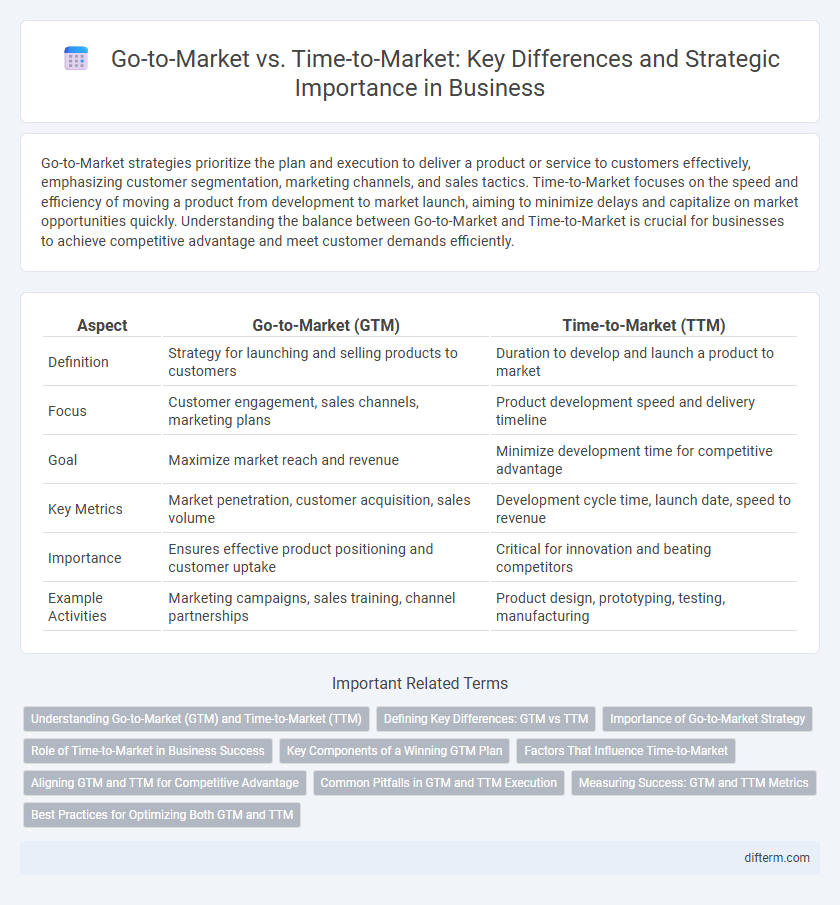Go-to-Market strategies prioritize the plan and execution to deliver a product or service to customers effectively, emphasizing customer segmentation, marketing channels, and sales tactics. Time-to-Market focuses on the speed and efficiency of moving a product from development to market launch, aiming to minimize delays and capitalize on market opportunities quickly. Understanding the balance between Go-to-Market and Time-to-Market is crucial for businesses to achieve competitive advantage and meet customer demands efficiently.
Table of Comparison
| Aspect | Go-to-Market (GTM) | Time-to-Market (TTM) |
|---|---|---|
| Definition | Strategy for launching and selling products to customers | Duration to develop and launch a product to market |
| Focus | Customer engagement, sales channels, marketing plans | Product development speed and delivery timeline |
| Goal | Maximize market reach and revenue | Minimize development time for competitive advantage |
| Key Metrics | Market penetration, customer acquisition, sales volume | Development cycle time, launch date, speed to revenue |
| Importance | Ensures effective product positioning and customer uptake | Critical for innovation and beating competitors |
| Example Activities | Marketing campaigns, sales training, channel partnerships | Product design, prototyping, testing, manufacturing |
Understanding Go-to-Market (GTM) and Time-to-Market (TTM)
Go-to-Market (GTM) strategy defines how a company delivers its value proposition to customers through effective marketing, sales, and distribution channels. Time-to-Market (TTM) measures the duration from product conception to commercial availability, impacting competitive advantage and revenue potential. Optimizing both GTM and TTM is essential for accelerating product launch success and maximizing market penetration.
Defining Key Differences: GTM vs TTM
Go-to-Market (GTM) strategy focuses on how a company delivers its product or service to customers by aligning marketing, sales, and distribution channels to maximize market penetration. Time-to-Market (TTM) measures the speed at which a product moves from concept to launch, emphasizing efficient development and operational processes to gain competitive advantage. The key difference lies in GTM targeting customer engagement and revenue generation, while TTM prioritizes rapid product delivery and innovation cycles.
Importance of Go-to-Market Strategy
A robust Go-to-Market strategy is crucial for aligning product development with customer needs and market demand, ensuring effective distribution channels and targeted marketing efforts. It directly impacts revenue growth by optimizing customer acquisition, retention, and competitive positioning in the business landscape. Neglecting a strategic Go-to-Market plan can result in missed opportunities, inefficient resource allocation, and delayed market adoption despite rapid product development times.
Role of Time-to-Market in Business Success
Time-to-Market (TTM) plays a critical role in business success by enabling companies to launch products faster than competitors, capturing market share and responding swiftly to consumer demand. Shorter TTM reduces development costs and accelerates revenue generation, improving overall profitability and competitive positioning. Efficient TTM processes support innovation cycles and help businesses adapt to dynamic market trends, fostering sustainable growth.
Key Components of a Winning GTM Plan
A winning Go-to-Market (GTM) plan hinges on understanding target customer segments, defining clear value propositions, and aligning sales and marketing strategies for optimal market penetration. Key components include thorough market research, competitive analysis, channel strategy, and cross-functional collaboration to ensure product readiness and customer engagement. Effective GTM execution accelerates revenue growth and builds sustainable competitive advantage, distinct from the speed-focused metrics of Time-to-Market.
Factors That Influence Time-to-Market
Time-to-market is influenced by factors such as product complexity, resource allocation, and supply chain efficiency, which directly impact the speed of launching new products. Efficient project management methodologies and agile development practices help reduce delays in production and testing phases. Market readiness, regulatory approvals, and cross-functional collaboration further determine the overall time-to-market duration for business success.
Aligning GTM and TTM for Competitive Advantage
Aligning Go-to-Market (GTM) and Time-to-Market (TTM) strategies enhances a company's competitive edge by ensuring rapid product delivery while effectively reaching target customers. Synchronizing product development timelines with marketing and sales efforts maximizes market impact and accelerates revenue generation. Companies that optimize this alignment reduce time delays and improve customer adoption rates, resulting in sustained market leadership.
Common Pitfalls in GTM and TTM Execution
Common pitfalls in Go-to-Market (GTM) execution include inadequate market research, unclear customer segmentation, and misaligned sales and marketing strategies, which lead to weak product positioning and missed revenue targets. Time-to-Market (TTM) challenges often stem from inefficient development cycles, lack of cross-functional collaboration, and failure to prioritize features based on customer value, causing delayed product launches and lost competitive advantage. Ignoring these pitfalls compromises business agility and market responsiveness, ultimately impacting growth and profitability.
Measuring Success: GTM and TTM Metrics
Go-to-Market (GTM) and Time-to-Market (TTM) metrics are critical for evaluating product success and market impact. GTM metrics prioritize customer acquisition rates, sales pipeline velocity, and market penetration, reflecting the effectiveness of marketing and sales strategies. TTM metrics focus on development cycle duration, launch timeline adherence, and speed of iteration, indicating operational efficiency and competitive responsiveness.
Best Practices for Optimizing Both GTM and TTM
Aligning Go-to-Market (GTM) strategies with efficient Time-to-Market (TTM) processes accelerates product success and maximizes revenue potential. Implementing agile development frameworks and cross-functional collaboration ensures rapid iteration while meeting customer needs effectively. Leveraging data-driven market analysis and real-time feedback loops optimizes launch timing and strategic positioning for competitive advantage.
Go-to-Market vs Time-to-Market Infographic

 difterm.com
difterm.com